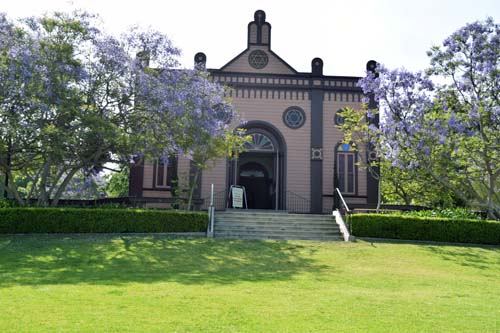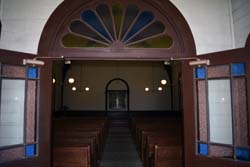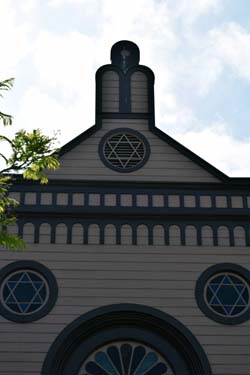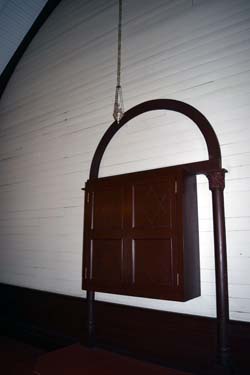
-Twelfth in a Series-
Exit 3, Taylor Street, San Diego: Temple Beth Israel, Heritage Park
By Donald H. Harrison

SAN DIEGO—Many fine carriages pulled up to the new building at the corner of 2nd and Beech Streets on a hill overlooking downtown San Diego and the Bay. Their occupants came to observe or to participate in High Holy Day services of 1889. It was the first time that the building, with windows stained with Magen David designs, and a roof line featuring the Tablets of the Law, came into official use. Up until then, Jewish religious services in San Diego were held in homes or in rented quarters. To celebrate the occasion, not only Jews, but also Christians in civic and business leadership positions, attended the Reform services.
As part of the transition from a homeless, wandering congregation to one with its own home, Congregation Adath Jeshurun, which had been the Jewish communal name since the early 1860s, changed its name to Congregation Beth Israel. It made sense because the old name roughly translated meant “The Gathering of the Faithful,” whereas the new name meant “The House of Israel.” And indeed, the Jews of San Diego now had a fine house of worship, which cost approximately $8,500 to build. About $1,500 of that total had been raised in March 1889 by the women of the congregation who staged a week-long Jewish Fair that featured booths, entertainment and food. According to a congregational history celebrating Beth Israel’s 150th anniversary, some of the other funds came from the sale of seats that could be reserved for family members during services..

As described in the San Diego Union of that period, the temple measured 56 x 30 feet, with two small rooms on either side of its entrance. Over the years, those rooms had such uses as an office for the clergy and a changing room for a bride. The walls of the sanctuary were painted gray, the ceiling sky blue, and 250 numbered chairs faced the Holy Ark (Aron Kodesh) carved from sugar pine with redwood panels, with an eternal light (Ner Tamid) suspended from the ceiling. The aisles were carpeted with cocoa and plain matting. A chandelier hung from the ceiling at the center of the room.
Not in evidence on the day that Temple Beth Israel celebrated its first Rosh Hashanah was a rabbi. The clergyman who previously had been employed, and who, in fact, had urged the construction of the Temple building, was no longer affiliated with the congregation. What had happened to Rabbi Samuel Freuder? The answer was that, for reasons unknown, he had converted to Christianity and was becoming a missionary for that faith.

He joined one Protestant sect after another, seemingly never satisfied with what he found. By 1915, he decided he had made a big mistake and reaffiliated as a Jew, writing a pamphlet titled: A Missionary’s Return to Judaism: The Truth About the Christian Missions to the Jews. In the pamphlet, he decried what he considered deceptive practices on the part of his former missionary colleagues.
Mirroring San Diego’s economic boom and bust cycles, the membership of Temple Beth Israel grew and shrank. The first spiritual leader to preach in the temple was Rabbi Marx Moses, whose tenure lasted three years until the Panic of 1893. In his short time as Beth Israel’s rabbi, he had persuaded the City of San Diego to set aside land for the Home of Peace Cemetery adjacent to the non-denominational Mount Hope Cemetery. He also helped to establish the Mothers Club of Beth Israel which helped to support the congregation’s religious school.
For the next 16 years, Beth Israel barely hung on without a rabbi, its membership at one point dwindling to 14 families. By the time the congregation felt financially secure enough to hire Rabbi Emil Ellinger in 1909, it had already undergone a split. Immigrants from Eastern Europe, who originally sought permission to worship as a separate Orthodox minyan, were unable to complete their High Holy Day worship in the one-room temple before members of the original Reform congregation asked them to hurry up and shorten their service. Incensed, they decided to form a synagogue of their own, which in 1906 they named Tifereth Israel, meaning “the Glory of Israel.”

Ellinger drew the wrath of Beth Israel congregants in 1911 when he officiated at a wedding between a Jewish man and Catholic woman. Amid the anger over the intermarriage, Ellinger submitted his resignation. Over the next 15 years, until 1926, the congregation hired six rabbis in succession, none staying more than four years. But the congregation continued to grow, and in 1926, it moved to much larger quarters at 3rd and Laurel Street into a Moorish style synagogue that would last it three quarters of a century, until 2000 when it moved to its own campus in the University City neighborhood of San Diego.
The original building at 2nd and Beech subsequently was utilized by Christian denominations and later by a Spiritualist congregation until, decaying and underutilized, it faced destruction by builders anxious to put up something more modern on that lot. Jim Milch, a congregant of Temple Beth Israel joined forces with the Save Our Heritage Organization (SOHO) to move the old temple to county-owned Heritage Park, two blocks up Juan Street from Old Town San Diego State Historic Park. Here it was restored to its original condition and is now rented for meetings by civic and religious groups of any denomination.

One of the questions I always like to ask groups that join me in Old Town tours is “who do you think sat up there in the balcony?” Typically, people responded, “the women.” But that wasn’t the case. The Reform congregation permitted men and women to sit together in the main sanctuary. The balcony at one time housed an organ, as well as people who came too late to services to get a seat on the main floor.
Beth Israel at 3rd and Laurel Streets; Tifereth Israel, which moved from 18th and Market to 30th and Howard; and Beth Jacob Congregation, which was located along 30th Street, for a while were the only three congregations in San Diego. Beth Israel was Reform. Tifereth Israel switched from Orthodox to Conservative, and Beth Jacob switched from Conservative to Orthodox. The three post World War II rabbis—Morton Cohen at Beth Israel; Monroe Levens at Tifereth Israel, and Baruch Stern at Beth Jacob – were friendly and collegial, often guest lecturing at each other’s synagogues. Later with San Diego’s growth many additional synagogues were begun, and today one could say there is not one but six San Diego communities.
The first is central San Diego, where the Conservative congregation Ohr Shalom Synagogue today occupies the 3rd and Laurel building that was formerly Beth Israel’s. The second area is the College-Del Cerro-San Carlos neighborhoods to which both Beth Jacob and Tifereth Israel moved in the 1970s. The third is the Chula Vista-Tijuana areas, with two synagogues on each side of the U.S.-Mexico border. The fourth is La Jolla and University City, where the modern Beth Israel is located today, along with such other large congregations as the Conservative Congregation Beth El and the Orthodox Congregation Adat Yeshurun, which revived the name of San Diego’s first wandering congregation. The fifth and sixth Jewish communities are up the northern stretches of San Diego County along coastal Interstate 5 and inland Interstate 15.
In three of the regions there are Hillel Houses associated with local universities, and throughout San Diego there are numerous small congregations operated by Chabad.
Next: Riverwalk Golf Course
*
Harrison is editor of San Diego Jewish World. Your comment may be sent to donald.harrison@sdjewishworld.com or posted on this website, provided that the rules below are observed.